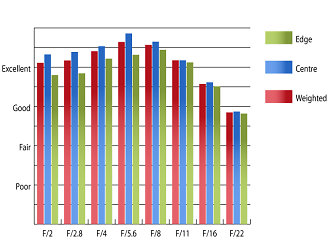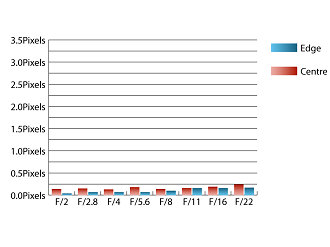Samyang 135mm f/2 ED UMC Lens Review
Samyang 135mm f/2 ED UMC Performance
At f/2, sharpness in the centre of the frame is excellent, and towards the edges of the frame, performance is very good. Stopping down improves sharpness even more, with peak performance being realised between f/5.6 and f/8. Here clarity is outstanding in the centre and excellent towards the edges of the frame.
How to read our charts
The blue column represents readings from the centre of the picture frame at the various apertures and the green is from the edges. Averaging them out gives the red weighted column.The scale on the left side is an indication of actual image resolution. The taller the column, the better the lens performance. Simple.
For this review, the lens was tested on a Canon EOS 5D Mark III using Imatest.
Chromatic aberrations are kept under control, remaining well under a quarter of a pixel width in size at all apertures. These low levels of fringing should be difficult to spot, even in very large prints, or harsh crops from the edges of the frame.
How to read our charts
Chromatic aberration is the lens' inability to focus on the sensor or film all colours of visible light at the same point. Severe chromatic aberration gives a noticeable fringing or a halo effect around sharp edges within the picture. It can be cured in software.Apochromatic lenses have special lens elements (aspheric, extra-low dispersion etc) to minimise the problem, hence they usually cost more.
For this review, the lens was tested on a Canon EOS 5D Mark III using Imatest.
Falloff of illumination towards the corners is quite strong, as is typical of fast standard lenses. The corners are 2.07 stops darker than the image centre at f/2 and visually uniform illumination isn't achieved until the aperture is stopped down to f/5.6 or beyond.
Imatest only detected 0.112% pincushion distortion, which is an extremely low amount and should very rarely need correction in image editing software afterwards.
There were few issues with flare with this lens during testing as the multicoatings applied to optical surfaces seem to do a good job of keeping this under control, as does the supplied circular hood. When shooting into the light, you may encounter a loss of contrast, but only in extreme examples of this kind of lighting.
Add your message
Please login here or if you've not registered, you can register here. Registering is safe, quick and free.
photodo Stats
428 MTF tests
74 in-depth photodo reviews
100+ users join each day
Help the lens community by reviewing or rating a lens today via our lens search
Latest Lens Reviews
- Chinon 28mm f/2.8 Vintage Lens Review
- Canon EF 70-200mm f/4L IS II USM Lens Review
- Samyang AF 85mm f/1.4 EF Review
- Sigma 70mm f/2.8 DG Macro Art Review
- Samyang AF 24mm f/2.8 FE Review
- Meike 50mm f/1.7 Review
- Tamron 70-210mm f/4 Di VC USD Review
- Lensbaby Burnside 35mm f/2.8 Review
- Asahi Super Takumar 50mm f/1.4 Review
- Asahi Super-Multi-Coated Takumar 135mm f/3.5 Review


